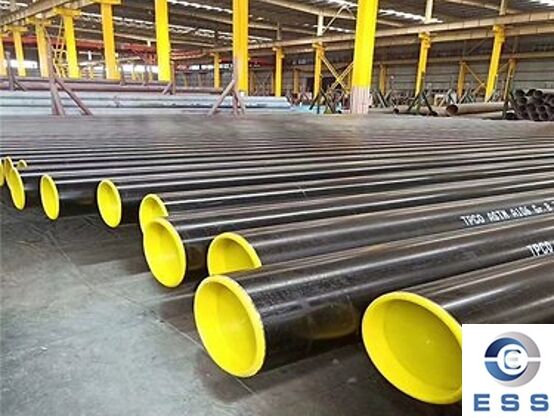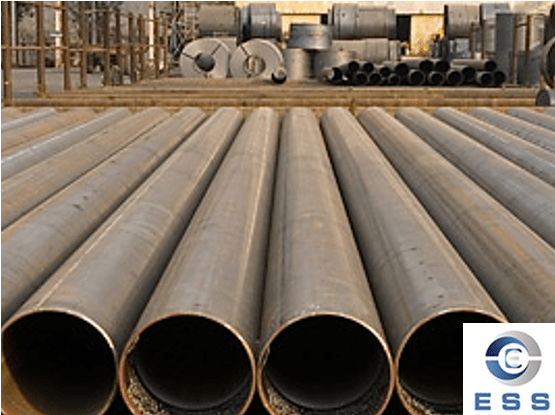
EN 10210 and EN 10219 are two common steel
pipe standards in the European market. They have their own characteristics in
production requirements, application scenarios and technical specifications.
The following will give you a detailed introduction.
Overview of EN 10210 standards
EN 10210 is another standard in the
European steel pipe industry, which is specifically used for the production and
application of hot-rolled steel pipes. Unlike EN 10219, EN 10210 mainly covers
the relevant requirements of hot-rolled seamless
steel pipe, and is mainly used in structures that need to withstand high
pressures and high temperatures.
1. Contents of EN 10210 standard
Material requirements: The material
requirements of hot-rolled seamless steel pipes are strict, covering the
chemical composition, physical properties, etc. of different alloy steels and
non-alloy steels.
Production process requirements: Clearly
stipulate the hot rolling process of seamless steel pipes, especially the
requirements for cooling speed, dimensional accuracy, etc. of steel pipes
during the production process.
Inspection and quality control: Including
quality inspection standards such as size, wall thickness, and mechanical
properties of seamless steel pipes to ensure that the steel pipes meet relevant
performance requirements.
2. Classification of EN 10210
The EN 10210 standard divides hot-rolled
seamless steel pipes into two categories:
Non-alloy steel pipes: Used in ordinary
buildings and structural engineering, such as industrial facilities, storage
facilities, etc.
Alloy steel pipes: Due to the addition of
alloy elements, this type of steel pipe has higher strength, corrosion
resistance and better high temperature resistance, and is suitable for more
demanding environments, such as high temperature and high pressure energy
facilities.
3. Common applications of EN 10210
Hot-rolled seamless steel pipes of EN 10210
standard are mainly used in the following aspects:
High temperature and high pressure
equipment: Such as boilers, pressure vessels and other equipment with high
strength requirements.
Industrial structures: Including heavy
structures such as pipe supports and industrial plants.
Energy industry: Especially in the
transportation pipelines of oil and natural gas, alloy steel pipes are often
used, which have good corrosion resistance and high temperature resistance.
Overview of EN 10219 standards
EN 10219 is a standard for cold-formed
welded structural steel pipes issued by the European Committee for
Standardization (CEN). This standard applies to cold-formed welded
steel pipes, that is, steel pipes manufactured by cold forming methods,
which are widely used in building structures, bridge construction,
transportation facilities and other fields.
1. Contents of EN 10219 standard
Material requirements: Including chemical
composition, mechanical properties, dimensional tolerances, etc. of welded
steel pipes.
Manufacturing requirements: Detailed
description of technical details such as production methods, welding processes,
and cold-formed forming processes of cold-formed welded steel pipes.
Quality control: Strict regulations are
imposed on the quality requirements of each welded steel pipe to ensure the
performance of the product in harsh environments such as high strength and high
pressure.
2. Classification of EN 10219
The EN 10219 standard divides cold-bent
welded steel pipes into two categories: non-alloy steel pipes (EN 10219-1) and
alloy steel pipes (EN 10219-2). There are certain differences in the
application of these two types of steel pipes, as follows:
Non-alloy steel pipes: Suitable for
conventional structural construction, commonly seen in building steel
structures, bridges, support systems, etc.
Alloy steel pipes: Due to the addition of
alloy elements, this type of steel pipe has stronger corrosion resistance, high
temperature resistance and better mechanical properties, and is suitable for
projects in special environments, such as tubing, natural
gas pipeline, heat
exchanger tube, etc.
3. Common applications of EN 10219
Steel pipes of EN 10219 standard are often
used in the following projects:
Building structures: As important
load-bearing components, cold-bent welded steel pipes are widely used in modern
building structures, especially in the construction of high-rise buildings,
large bridges, industrial plants, etc.
Bridge construction: Due to the high
strength and light weight of cold-bent welded steel pipes, they are widely used
in the support and structural systems of bridges.
Energy field: In the construction of oil
and gas pipelines, alloy steel pipes are manufactured according to EN 10219
standards and can withstand high pressures and temperatures.
Differences between EN
10210 and EN 10219
1. Differences in production process
EN 10210 standard involves the production
process of hot-rolled seamless steel pipes. The steel pipes are heated, rolled
and then cooled. The production process of hot-rolled seamless steel pipes is
relatively complex. They are suitable for applications with higher temperatures
and pressures. They are often used in structures with high strength
requirements and pipes in high-temperature environments.
EN 10219 standard mainly involves the
production process of cold-bent welded steel pipes. Cold-bent welded steel
pipes are rolled into tubes by cold forming technology and welding process.
Since there is no heating in the production process, the internal stress of the
steel pipe is small and the surface quality is high, which is suitable for
conventional buildings and structures.
2. Different application scenarios of steel
pipes
EN 10210 standard hot-rolled seamless steel
pipes are more used in high-temperature and high-pressure environments, such as boiler
tube, oil and gas pipeline, and structure of high-temperature equipment.
EN 10219 standard cold-bent welded steel
pipes are usually used in fields with high bearing capacity requirements such
as building structures and bridge construction, and are suitable for
conventional construction and structural engineering.
3. Differences in material and performance
requirements
EN 10210 standard has more stringent
requirements for alloy steels, especially for performance requirements in
high-temperature environments, including strength, corrosion resistance and
high-temperature resistance.
EN 10219 standard has relatively broad
requirements for the material of steel pipes, covering different non-alloy
steels and alloy steels, and mainly focusing on the mechanical properties and
welding properties of steel pipes.
4. Different applicable production
equipment
Due to the process differences between
cold-bending welding and hot-rolling production, the production of steel pipes
in accordance with EN 10219 standard mainly relies on cold forming machines and
welding equipment, while the production of steel pipes in accordance with EN
10210 standard relies on equipment such as hot rolling mills and
high-temperature heating furnaces.
Basis for choosing EN 10210 and EN 10219
When choosing EN 10210 and EN 10219 steel
pipes, enterprises need to decide based on specific application requirements:
1. Environmental requirements
If the project involves harsh environments
such as high temperature and high pressure, it is recommended to choose
hot-rolled seamless steel pipes in accordance with EN 10210 standard. If the
application environment is relatively conventional, cold-bent welded steel
pipes in accordance with EN 10219 standard can be selected.
2. Performance requirements
For pipes that require higher corrosion
resistance and high temperature resistance, hot-rolled seamless steel pipes in
accordance with EN 10210 standard are more suitable. For conventional buildings
and infrastructure, EN 10219 cold-bent welded steel pipes are sufficient to
meet the needs.
3. Production process
For steel pipes in building structures and
other fields, cold-formed welded steel pipes (EN 10219) are more
cost-effective; for high-strength pipes in the energy, oil and gas industries,
hot-rolled seamless steel pipes (EN 10210) are a better choice.
Read more: EN 10220 vs EN 10210













 Eastern Steel Manufacturing Co.,Ltd not only improve product production and sales services, but also provide additional value-added services. As long as you need, we can complete your specific needs together.
Eastern Steel Manufacturing Co.,Ltd not only improve product production and sales services, but also provide additional value-added services. As long as you need, we can complete your specific needs together.










